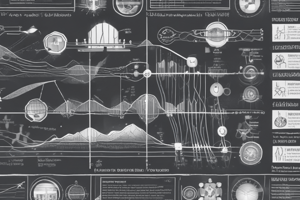Podcast
Questions and Answers
What does the Simple View model demonstrate about decoding and language comprehension?
What does the Simple View model demonstrate about decoding and language comprehension?
- Proficiency in one domain can make up for a lack of proficiency in the other.
- Both decoding and language comprehension are equally important for reading comprehension.
- Lack of proficiency in one domain cannot be compensated for by the other. (correct)
- Weaknesses in decoding can be compensated for by strong language comprehension.
How does the Reading Rope model contribute to understanding reading skills?
How does the Reading Rope model contribute to understanding reading skills?
- It explores the role of phonics in reading instruction.
- It emphasizes the importance of fluency in reading.
- It explains how brain imaging techniques work in reading research.
- It focuses on the connection between decoding and language comprehension. (correct)
What is the role of the context processor in reading?
What is the role of the context processor in reading?
- It helps in automatic word recognition.
- It connects visual input to speech processing areas.
- It represents the outward behavioral manifestation of automaticity.
- It sorts through different meanings of words based on context. (correct)
How do the top and bottom strands of the Reading Rope initially develop?
How do the top and bottom strands of the Reading Rope initially develop?
What is the key aspect that allows for remodeling in the brain through targeted reading interventions?
What is the key aspect that allows for remodeling in the brain through targeted reading interventions?
How do brain imaging studies contribute to understanding reading development?
How do brain imaging studies contribute to understanding reading development?
What is the main focus of the first presentation in the Science of Reading series?
What is the main focus of the first presentation in the Science of Reading series?
Who are the presenters of the Science of Reading series?
Who are the presenters of the Science of Reading series?
Which individual recently started a new position as associate director of school improvement for CESA 9 in Wisconsin?
Which individual recently started a new position as associate director of school improvement for CESA 9 in Wisconsin?
What does decoding refer to in the context of reading?
What does decoding refer to in the context of reading?
According to the Simple View of Reading, what are the two components that contribute to reading comprehension?
According to the Simple View of Reading, what are the two components that contribute to reading comprehension?
Who provides a concise explanation of the Science of Reading in a video presentation?
Who provides a concise explanation of the Science of Reading in a video presentation?
Study Notes
- Three events are being presented today in the Science of Reading series at 9:00, 10:45, and 1:00.
- Hundreds of advanced questions were submitted, with a live Q&A session after each presentation.
- Certificates of attendance can be requested through a Google form shared in the email.
- The presenters are Mary Newton, president of Reading League Wisconsin, and Amy McGovern, vice president.
- Amy McGovern recently started a new position as associate director of school improvement for CESA 9 in Wisconsin.
- Mary Newton's journey into reading began when her youngest child was diagnosed with dyslexia.
- The first presentation introduces the Science of Reading, including definitions, conceptual models, and brain studies.
- Recommended books for further reading include works by David Kilpatrick, Mark Seidenberg, Stanislas Dehaene, and Sally Shaywitz.
- The Science of Reading is defined as an accumulation of basic clinical and brain research from various fields.
- Stephanie Staller provides a concise explanation of the Science of Reading in a video presentation.- The Simple View of Reading posits that reading comprehension is the result of decoding (word recognition) and language comprehension, expressed as a mathematical formula.
- Decoding involves word-level reading and includes phoneme awareness, letter names, and mapping speech to print.
- Language comprehension includes background knowledge, vocabulary, reasoning skills, and critical thinking skills.
- The Simple View model shows that proficiency in one domain (decoding or language comprehension) cannot compensate for a lack of proficiency in the other when it comes to reading comprehension.
- The model demonstrates that weaknesses in both decoding and language comprehension domains multiply and impact reading comprehension outcomes.
- Proficiency in both decoding and language comprehension domains is necessary for optimal reading comprehension.
- The model has implications for designing effective reading instruction and interventions based on individual student needs.
- The Reading Rope model by Hollis Scarborough provides a detailed breakdown of sub-skills within the decoding and language comprehension domains.
- Fluency in reading is a byproduct of automatic word recognition, representing the outward behavioral manifestation of automaticity in the brain.
- The top (language comprehension) and bottom (word recognition) strands of the Reading Rope initially develop separately and must be mastered for skilled reading to occur.- Before brain imaging techniques, researchers used computational models to hypothesize how the brain processes written words.
- The four brain areas identified in the model work together when reading text: orthographic processor, phonological processor, meaning processor, and context processor.
- Communication between the orthographic and phonological processors happens through phonics.
- The context processor helps sort through different meanings of words based on the context.
- Brain imaging technologies like PET scans, fMRIs, and MEG have advanced understanding of how reading develops.
- Brain imaging studies over three decades have explored brain circuits for reading in good and poor readers.
- Questions in brain science related to reading include brain circuits for reading, differences in good and poor readers' brains, and effective interventions.
- Reading involves connecting visual input at the back of the brain to meaning and speech processing areas in the brain.
- The brain's plasticity allows for remodeling through targeted reading interventions, even in dyslexic individuals.
- FMRI and MEG imaging provide insights into brain activity during reading, showing the process from visual input to speech and meaning processing.
Studying That Suits You
Use AI to generate personalized quizzes and flashcards to suit your learning preferences.
Description
Explore advanced questions related to the Science of Reading series presentations by Mary Newton and Amy McGovern. Learn about decoding, language comprehension, brain studies, the Simple View of Reading, the Reading Rope model, and implications for reading instruction. Understand how brain imaging technologies have advanced understanding of reading development.




